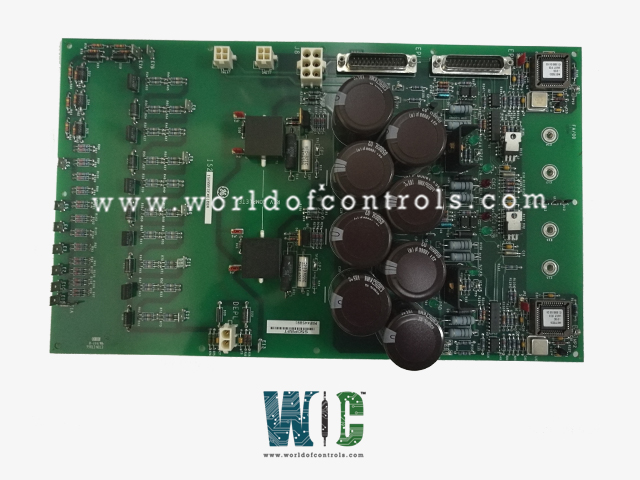SPECIFICATIONS
Part No.: IS200EDEXG2B
Manufacturer: General Electric
Country of Manufacture: United States of America (USA)
Technology: Surface-mount
Temperature Operating: -30 to 65oC
Product Type: Exciter De-Excitation Control Board
Availability: In Stock
Series: EX2100e
Functional Description
IS200EDEXG2B is an Exciter De-Excitation Control Board developed by GE. It is a part of EX2100e excitation system. The exciter de-excitation control board (EDEX) serves as the primary board within the de-excitation module of a generator system. Its primary function is to swiftly and efficiently remove stored energy from the generator field during emergency shutdown situations. This process is crucial when the field breaker or contactors open, ensuring the safe and controlled de-energizing of the generator.
Functions and Capabilities
- SCR Firing: The board is responsible for the Silicon Controlled Rectifier (SCR) firing. This process involves triggering the SCRs to conduct current and thereby rapidly dissipate the energy stored in the generator field.
- Conduction Sense Feedback: The board provides feedback on the conduction status of the SCRs. This feedback is essential for monitoring the de-excitation process, ensuring that the SCRs are functioning correctly and the energy dissipation is proceeding as expected.
- Voltage Retention: Designed to retain voltage to ensure continuous operation even in the event of a power failure. This capability is critical for maintaining control over the de-excitation process and preventing potential damage to the generator and associated systems.
Integration with Other System Components
- Initiation of De-Excitation by EMIO: The de-excitation process is initiated by the board, which sends a signal to the EXTB board. This initial signal is the trigger for the entire de-excitation sequence, starting with the opening of the field contactors or breaker.
- Role of the EXTB Board: Upon receiving the initiation signal from EMIO, the EXTB board takes action to open the 41dc contactor (MDA/MDB) or the breaker. This step physically disconnects the generator field, a crucial step in halting the energy generation and initiating the de-excitation process.
- Transfer of De-Excitation Signals: After the contactor or breaker is opened, the EXTB board transfers the de-excitation signals from the auxiliary contacts to the SCR firing circuits on the EDEX board. This transfer is a critical part of the sequence, ensuring that the EDEX board receives the correct signals to manage the de-excitation process effectively.
Conduction Sensors
- Hall Effect Sensors for Current Detection: It utilizes Hall Effect sensors to detect current in the field circuit. Hall Effect sensors are known for their precision and reliability in current detection, making them ideal for this application. These sensors work by detecting the magnetic field generated by the current flowing through the field circuit.
- Mechanical Ring Coupling: A mechanical ring is employed to couple the magnetic flux generated by the current to the Hall Effect sensors. This ring is strategically placed to guide the magnetic flux towards the sensors, which are located at the top edge of the board. The design ensures that the sensors can accurately detect changes in the magnetic field, thus measuring the current flow precisely.
- Bi-Polar and Uni-Polar Current Detection: The board features two separate sensor circuits, referred to as sensor circuits 1 and 2, which are capable of detecting bi-polar current flow. This means that the sensors can detect current flowing in both directions, which is essential for comprehensive monitoring of the field circuit. The signals from these sensors, labeled as M1 and M2 current sense signals, are transmitted to the EXTB board and subsequently to the control system. For applications involving diode de-excitation, the mechanical ring is configured to detect unidirectional current flow. This configuration ensures that the system can accurately monitor and respond to the specific requirements of diode-based de-excitation processes.
- Status Indicators: Equipped with two red LEDs that serve as status indicators for the current sense circuits. These LEDs provide a visual indication of current flow detection. Whenever current is detected by either of the sensor circuits, the corresponding LED lights up. This immediate visual feedback is useful for operators and technicians to quickly verify the operational status of the conduction sensors.
The WOC team is always available to help you with your EX2100e requirements. For more information, please contact WOC.
Frequently Asked Questions
What is IS200EDEXG2B?
It is an Exciter De-Excitation Control Board developed by GE under the EX2100e series.
What are the conduction sensors on the board used for?
Conduction sensors on the board are used to detect and monitor current flow in the generator's field circuit. This detection is crucial for managing the de-excitation process and ensuring the safe operation of the generator.
How do the Hall Effect sensors work on the board?
Hall Effect sensors on the board detect current by measuring the magnetic field generated by the current flow in the field circuit. The sensors convert the magnetic field data into electrical signals that can be processed to determine the current flow.
What role does the mechanical ring play in current detection?
The mechanical ring couples the magnetic flux generated by the current to the Hall Effect sensors. This coupling ensures that the sensors receive accurate and consistent magnetic field data, allowing for precise current detection.
